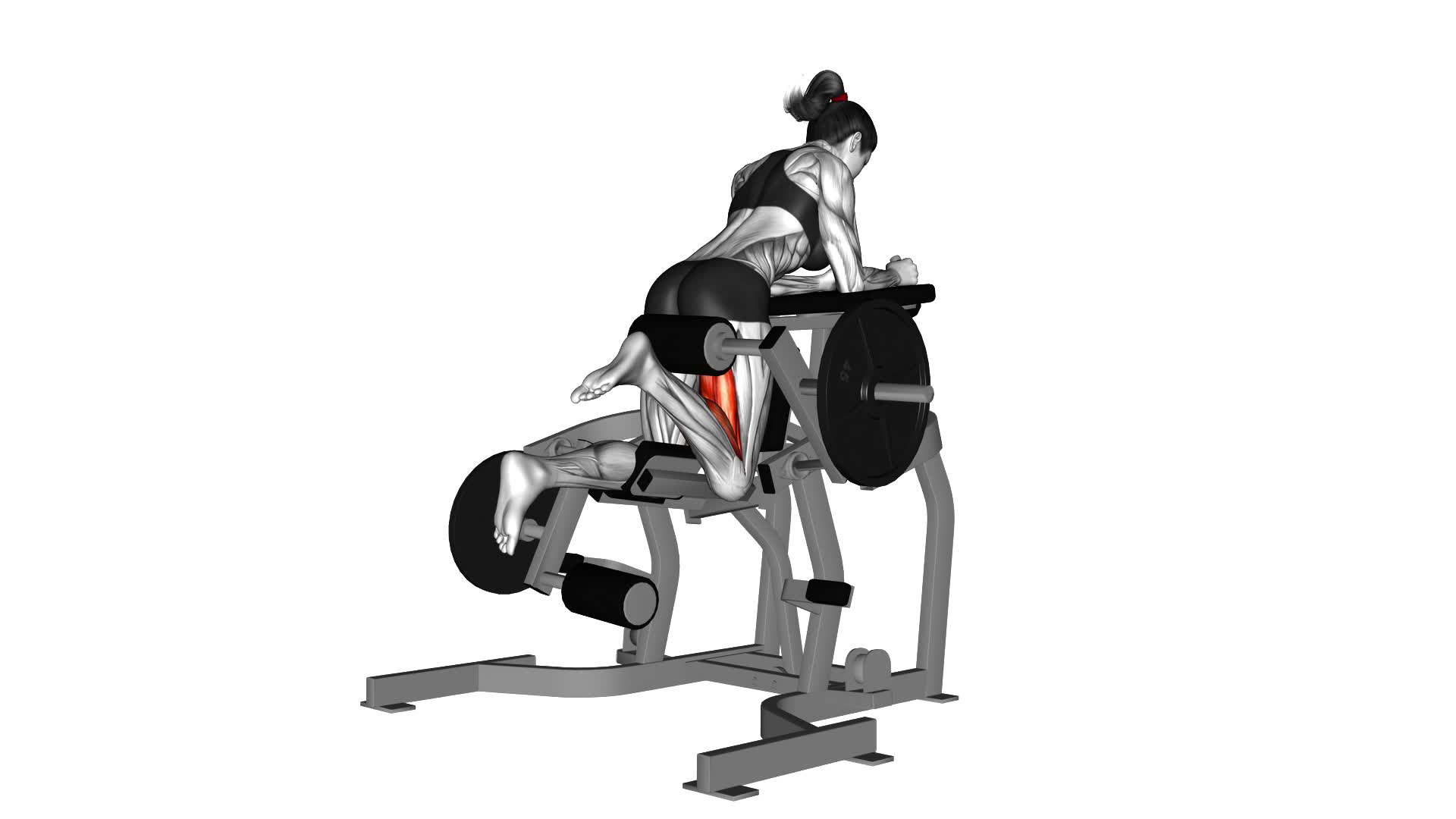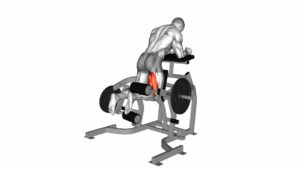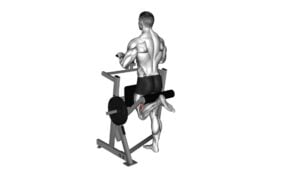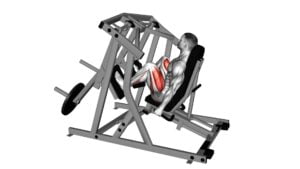Lever Kneeling Leg Curl (Plate Loaded) (Female) – Video Exercise Guide & Tips

Are you looking for a challenging lower body exercise that targets your hamstrings? Look no further than the lever kneeling leg curl.
Watch This Exercise Video
This exercise, specifically designed for female athletes, utilizes a plate loaded machine to provide resistance.
In this video exercise guide, we'll show you the proper form and technique, common mistakes to avoid, variations and progressions, and offer tips to make your workout more effective.
Get ready to strengthen and tone your hamstrings like never before.
Key Takeaways
- Lever kneeling leg curl is highly effective in activating and strengthening the hamstring muscles.
- Proper form and technique, such as maintaining core engagement and avoiding arching the back, are crucial for this exercise.
- Avoid common mistakes like using too much weight, swinging the legs, or neglecting tension on the hamstrings.
- To maximize the benefits, try variations and progressions, warm up before the exercise, and cool down/stretch afterwards.
Benefits of Lever Kneeling Leg Curl
Discover the numerous benefits you can experience from incorporating the Lever Kneeling Leg Curl into your fitness routine. This exercise is highly effective in muscle activation and injury prevention.
The Lever Kneeling Leg Curl specifically targets the hamstrings, which are crucial for lower body strength and stability. By activating and strengthening these muscles, you can improve your overall athletic performance and prevent injuries.
One of the key benefits of this exercise is its ability to isolate and activate the hamstring muscles. The lever design of the machine allows for a controlled and targeted movement, ensuring that the hamstrings are effectively engaged throughout the entire range of motion. This helps to build strength, improve muscle balance, and enhance overall lower body function.
Additionally, the Lever Kneeling Leg Curl can aid in injury prevention. Strengthening the hamstrings can help stabilize the knee joint, reducing the risk of common injuries such as strains and tears. By incorporating this exercise into your routine, you can proactively protect yourself from potential setbacks and stay on track with your fitness goals.
Proper Form and Technique
To ensure proper execution of the Lever Kneeling Leg Curl exercise, it's important to focus on maintaining a correct form and technique. Proper alignment is crucial to target the intended muscles and prevent injuries. One common error is arching the back during the movement. This not only takes the focus away from the hamstrings but also puts unnecessary strain on the lower back. To avoid this, engage your core muscles and keep your back flat against the pad throughout the exercise.
Another common mistake is using momentum to lift the weight. This reduces the effectiveness of the exercise and increases the risk of injury. Instead, focus on using controlled movements and contracting the hamstrings to lift the weight. You should also avoid swinging the legs or lifting the hips off the bench.
Maintaining proper alignment is essential for maximizing the benefits of the Lever Kneeling Leg Curl. Make sure that your knees are in line with the machine's axis and your feet are securely placed against the foot pad. This will help you maintain stability and target the hamstrings effectively.
Common Mistakes to Avoid
To avoid making common mistakes and optimize your results, focus on maintaining proper form and technique during the Lever Kneeling Leg Curl exercise. Here are some common mistakes to avoid and tips for injury prevention:
- Using too much weight: It can be tempting to load up the weight, but using too much can lead to improper form and increased risk of injury. Start with a weight that allows you to perform the exercise correctly and gradually increase as you get stronger.
- Arching your back: Keep your back flat against the pad throughout the movement. Arching your back not only decreases the effectiveness of the exercise but also puts strain on your lower back.
- Jerking or swinging: Avoid using momentum to lift the weight. Focus on controlled and smooth movements, keeping tension on your hamstrings throughout the entire range of motion.
Variations and Progressions
To maximize your results and challenge your muscles in new ways, you can try different variations and progressions of the Lever Kneeling Leg Curl exercise. By incorporating advanced modifications and muscle activation strategies, you can take your workout to the next level.
One advanced modification you can try is increasing the weight load. As you become stronger, gradually add more weight to the machine to further challenge your muscles. This will help you build strength and definition in your hamstrings.
Another variation is performing the exercise unilaterally. Instead of using both legs at the same time, focus on one leg at a time. This won't only increase the difficulty but also improve muscle imbalances and stability.
You can also experiment with different tempos. Slow down the eccentric (lowering) phase of the movement to increase time under tension and enhance muscle activation. Alternatively, you can perform explosive concentric (lifting) movements to improve power and speed.
Incorporating these variations and progressions into your Lever Kneeling Leg Curl routine will keep your muscles guessing and prevent plateaus.
Now, let's move on to some tips for a more effective workout.
Tips for a More Effective Workout
To ensure a more effective workout, focus on engaging your muscles fully during the Lever Kneeling Leg Curl exercise. Here are some tips to help you get the most out of your workout:
- Warm up: Before starting any exercise, it's important to warm up your muscles. This helps increase blood flow to the muscles, making them more pliable and less prone to injury. You can warm up by doing some light cardio exercises like jogging or cycling for 5-10 minutes.
- Proper form: Pay attention to your form during the exercise. Keep your back straight and your core engaged. Avoid using momentum to lift the weight and instead focus on using your hamstring muscles to perform the movement. This will ensure that you're targeting the right muscles and getting the most benefit from the exercise.
- Cool down and stretch: After your workout, take the time to cool down and stretch your muscles. This helps prevent muscle soreness and stiffness by reducing the buildup of lactic acid in the muscles. Stretching also helps improve flexibility and range of motion.
Frequently Asked Questions
How Much Weight Should I Start With When Performing the Lever Kneeling Leg Curl Exercise?
When starting the lever kneeling leg curl exercise, it's important to choose a weight that challenges you but allows you to maintain proper form. Begin with a weight that you can comfortably complete 8-12 repetitions with.
If you have any injuries or limitations, it's crucial to modify the exercise accordingly. Consult with a fitness professional or physical therapist to determine the appropriate modifications for your specific needs.
Remember to always listen to your body and make adjustments as necessary.
Can This Exercise Be Modified for Individuals With Knee or Lower Back Issues?
If you have knee or lower back issues, modifications can be made to the lever kneeling leg curl exercise. Instead of using the plate-loaded machine, you can try alternative exercises that target similar muscle groups.
For knee issues, exercises like glute bridges or hamstring curls using resistance bands can be effective.
For lower back issues, exercises like deadlifts or seated leg curls can provide a safer alternative.
Always consult with a healthcare professional before starting any new exercise routine.
How Often Should I Perform the Lever Kneeling Leg Curl Exercise to See Results?
To see optimal results with the lever kneeling leg curl exercise, you should perform it with the right frequency. Consistency is key! Aim to do this exercise 2-3 times a week to allow your muscles to recover and grow.
Remember to gradually increase the weight used or the number of repetitions to ensure progressive overload and maximize gains. This will keep challenging your muscles and help you achieve the best results from the lever kneeling leg curl.
Is It Necessary to Warm up Before Doing This Exercise?
Before starting any exercise, warming up is essential. It helps increase blood flow to your muscles, prepares them for the workout, and reduces the risk of injury.
For beginners performing the lever kneeling leg curl, it's especially important to warm up as this exercise targets the hamstrings and can put strain on the knee joint if not done correctly.
Take the time to stretch and do some light cardio before diving into this exercise.
What Other Exercises Can I Incorporate Into My Workout Routine to Target the Same Muscle Groups as the Lever Kneeling Leg Curl?
To target the same muscle groups as the lever kneeling leg curl, you can incorporate workout alternatives like the seated leg curl, hamstring curls, or glute bridges.
These exercises also engage the hamstrings and glutes effectively. Remember to focus on proper form and gradually increase the intensity to avoid injury.
Adding variety to your routine will keep your muscles challenged and promote overall strength and stability in your lower body.
Conclusion
In conclusion, the lever kneeling leg curl is a highly effective exercise for strengthening and toning the hamstrings. By maintaining proper form and technique, you can maximize the benefits of this exercise while avoiding common mistakes.
Additionally, incorporating variations and progressions can help challenge your muscles and further enhance your workout. Remember to follow these tips for a more effective leg curl routine and enjoy the benefits of stronger and more defined hamstrings.

Author
Years ago, the spark of my life’s passion ignited in my mind the moment I stepped into the local gym for the first time. The inaugural bead of perspiration, the initial endeavor, the very first surge of endorphins, and a sense of pride that washed over me post-workout marked the beginning of my deep-seated interest in strength sports, fitness, and sports nutrition. This very curiosity blossomed rapidly into a profound fascination, propelling me to earn a Master’s degree in Physical Education from the Academy of Physical Education in Krakow, followed by a Sports Manager diploma from the Jagiellonian University. My journey of growth led me to gain more specialized qualifications, such as being a certified personal trainer with a focus on sports dietetics, a lifeguard, and an instructor for wellness and corrective gymnastics. Theoretical knowledge paired seamlessly with practical experience, reinforcing my belief that the transformation of individuals under my guidance was also a reflection of my personal growth. This belief holds true even today. Each day, I strive to push the boundaries and explore new realms. These realms gently elevate me to greater heights. The unique combination of passion for my field and the continuous quest for growth fuels my drive to break new ground.







